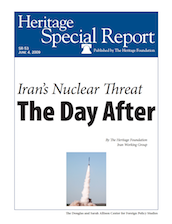In April and May 2009, AFPC Vice President for Policy Ilan Berman participated in a working group convened by The Heritage Foundation to analyze future U.S. policy options toward the Islamic Republic of Iran. The resulting study was published by The Heritage Foundation on June 5, 2009.
SYNOPSIS
The Islamic Republic of Iran, which has pursued policies hostile to the United States since its founding in 1979, is now on the brink of attaining a nuclear weapons capability. U.S. Director of National Intelligence Dennis Blair testified before Congress on March 10 that "We assess Iran has the scientific, technical, and industrial capacity to eventually produce nuclear weapons." Although it is not clear exactly when Iran will realize this goal, Blair also testified that "We judge Iran probably would be technically capable of producing enough highly enriched uranium (HEU) for a weapon sometime during the 2010-2015 timeframe." While estimates vary, it is clear that the world's foremost sponsor of terrorism soon will be able to build one of the world's most terrifying weapons.
What happens next? The answer is that the U.S. should not wait to find out. Rather, it should immediately put in place the foundations of a strategy to dissuade Tehran from attaining a nuclear weapon through adroit diplomacy, disarm it through military force, or establish a robust framework of augmented deterrence to mitigate the threat posed by a nuclear Iran. Washington must take stronger actions now to prevent a future disaster from unfolding. After all, the U.S. will be dealing not just with a nuclear Iran, but with a potential cascade of nuclear powers in the Middle East.
Want these sent to your inbox?
Subscribe
Iran’s Nuclear Threat: The Day After
Related Categories:
Economic Sanctions; Military Innovation; Missile Defense; Warfare; Iran; Middle East

